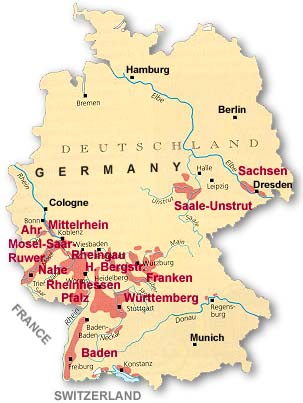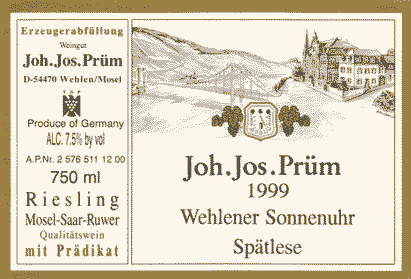Difference between revisions of "German Wine"
(→German wine growing regions) |
(→deciphering German wine labels) |
||
| (5 intermediate revisions by the same user not shown) | |||
| Line 18: | Line 18: | ||
== German wine growing regions == | == German wine growing regions == | ||
<html> | <html> | ||
| − | < | + | <img src="/images/german_wine_regions.jpg" height="403" width="303" border="0" usemap="#regions" style="display: block; margin-left: auto; margin-right: auto;"> |
<map name="regions"> | <map name="regions"> | ||
<area shape="rect" coords="51,292,94,306" onClick="alert('Pfaltz');" nohref alt="Pfalz"> | <area shape="rect" coords="51,292,94,306" onClick="alert('Pfaltz');" nohref alt="Pfalz"> | ||
| Line 38: | Line 38: | ||
These regions are further divided into Bereiche, or sub-regions, which are comprised of groups of vineyards called Grosslagen. | These regions are further divided into Bereiche, or sub-regions, which are comprised of groups of vineyards called Grosslagen. | ||
| + | |||
| + | == German wine classifications == | ||
| + | |||
| + | * '''Tafelwein''': lowest quality wine meant to be consumed with a meal | ||
| + | * '''Landwein''': a regional wine with a higher quality than that of Tafelwein | ||
| + | * '''Qualitätswein Bestimmter Anbaugebiete (QbA)''': commonly refered to as just Qualitätswein, this is wine produced from one of the 13 designated regions. It is from fully ripened grapes and the wine itself is tested by the German government for sugar and alcohol content. | ||
| + | |||
| + | A process called '''Chaptalization''' is commonly used with the above three classifications of wine, in which sugar is added to increase the alcohol content during fermentation. These wines tend not to be sweet and are usually labeled '''Trocken (dry)''' or '''Halbtroken (medium dry'''). | ||
| + | |||
| + | Qualitätswein mit Prädikat (QmP) - the highest quality German wines, subject to strict regulations governing their production. QmP are all-natural wines, in that there is no sugar added to the wine during the fermenting process. In order to produce a QmP wine, the grapes must contain enough natural sugars to complete the fermenting process. QmP wines are divided into these categories of increasing quality/sweetness: | ||
| + | |||
| + | # '''Kabinett''' | ||
| + | # '''Spätlese''' | ||
| + | # '''Auslese''' | ||
| + | # '''Beerenauslese (BA)''' | ||
| + | # '''Trockenbeerenauslese (TBA)''' | ||
| + | # '''Eiswein''' | ||
| + | |||
| + | == deciphering German wine labels == | ||
| + | |||
| + | German wine labels contain a host of information. Click on the parts of the label below for details: | ||
| + | |||
| + | <html> | ||
| + | <img src="/images/wine_label.gif" width="411" height="279" alt="German wine label" border="0" usemap="#label" style="display: block; margin-left: auto; margin-right: auto;"> | ||
| + | |||
| + | <map name="label"> | ||
| + | <area shape="rect" coords="180,154,341,175" nohref onClick="alert('Producer\n\nThe winery/vineyard where the grapes where grown.');" alt="Producer" title="Producer"> | ||
| + | <area shape="rect" coords="246,182,288,199" nohref onClick="alert('Vintage\n\nThe vintage is the year the grapes were harvested. Wine is an agricultural product and consequently very dependent on the weather which in Germany, unlike more southerly climates, can be extremely variable.');" alt="Vintage" title="Vintage"> | ||
| + | <area shape="rect" coords="178,208,356,225" nohref onClick="alert('Village Vineyard\n\nThe often difficult to pronounce names on the label indicate the village where the vineyard is located (identified by the -er suffix) followed by another name (often ending in -berg [=mountain, slope] indicating the vineyard site. Proprietary names like "Liebfraumilch" and "Bishop of Riesling" have no vineyard designation, they are a blend of wines from several vineyards.');" alt="Appellation/Vineyard" title="Appellation/Vineyard"> | ||
| + | <area shape="rect" coords="232,237,302,259" nohref onClick="alert('Category\n\nSee the section above about wine classifications.');" alt="Classification" title="Classification"> | ||
| + | <area shape="rect" coords="20,26,124,37" nohref onClick="alert('Bottler\n\nThe person or organization who bottled the wine. This can be different than the winery/vineyard.');" alt="Bottler" title="Bottler"> | ||
| + | <area shape="rect" coords="19,39,125,86" nohref onClick="alert('Bottling Location\n\nWhere the wine was bottled. This can be different than the winery/vineyard itself, and is often a coop of wine growers.');" alt="Bottling Location" title="Bottling Location"> | ||
| + | <area shape="rect" coords="59,88,83,118" nohref onClick="alert('Verband Deutscher Prädikats- und Qualitätsweingüter e.V.\n\nIndicates that this winery is a member of the Association of German Prädikat Wine Estates, an organization dedicated to making wines of the highest quality... wines which reflect the distinctive character of their German origin and grape variety. Its 200 member wine estates, which represent approximately three percent of the entire German viticultural area from nearly all of Germany\'s wine growing regions, share a long tradition of excellence in winemaking.\n\nsee http://www.vdp.de/ for more details.');" alt="V.D.P. Member" TITLE="V.D.P. Member"> | ||
| + | <area shape="rect" coords="27,118,124,129" nohref onClick="alert('Origin\n\n\Country of origin.');" alt="Origin" title="Origin"> | ||
| + | <area shape="rect" coords="45,131,105,147" nohref onClick="alert('Alcohol Content\n\nPercent of alcohol by volume.');" alt="Alcohol Conent" title="Alcohol Content"> | ||
| + | <area shape="rect" coords="24,154,124,163" nohref onClick="alert('Amtliche Prüfnummer\n\nMeaning "official approval number," this identifies the wine and is required for all QbA and QmP wines. It consists of several blocks of numbers identifying the wine like\n\n2 576 511 12 00\n\n2 stands for the testing center, where the wine was approved\n576 stands for the village in which the winery is located that produced the wine\n511 is the code number for the winery\n12 00 reflects that this is the 12th wine tested in the year 2000 (not necessarily related to the vintage of the wine, but most often the year after the vintage)\n\nThis coding enables the official testing centers to identify a wine. If there is any complaint or doubt of authenticity of the wine, sealed bottles which the winery has to keep for a number of years can be cross checked and tasted to investigate.');" alt="Amtliche Prüfnummer" title="Amtlich Prüfnummer"> | ||
| + | <area shape="rect" coords="50,169,100,185" nohref onClick="alert('Volume\n\nThe amount of wine in the bottle, which in this case is 750ml.');" alt="Volume" title="Volume"> | ||
| + | <area shape="rect" coords="23,191,119,211" nohref onClick="alert('Grape Variety\n\nThe grape variety used to make a wine is the single most influential factor determining its taste. Different grapes have different flavors, just like different fruits have different flavors. For example: Riesling is a very fruit-driven grape variety providing a fine acidity. Gewürztraminer has very floral, perfumed flavors reminiscent of rose peddles while Silvaner is lower in acidity and less floral, rather plain.');" alt="Grape Variety" title="Grape Variety"> | ||
| + | <area shape="rect" coords="21,212,121,227" nohref onClick="alert('Region\n\nTo identify the region compare with the list of the 13 German wine growing regions.');" alt="Region" title="Region"> | ||
| + | <area shape="rect" coords="21,228,120,259" nohref onClick="alert('Classification\n\nSee the section above about wine classifications.');" alt="Classification" title="Classification"> | ||
| + | <area shape="default" nohref> | ||
| + | </map> | ||
| + | </html> | ||
| + | |||
| + | Note: the dryness of this wine is not indicated on the label, which implies that it is a sweet wine. The taste / style or level of dryness of a wine depends on the cellar master and is determined in the cellar by the winemaker; it is totally independent of the grape. | ||
| + | |||
| + | Dryness levels are not to be confused with ripeness categories, which depend on the ripeness of the grapes harvested in the vineyard. Other notes: | ||
| + | |||
| + | * '''Trocken''' indicates dry wine without perceptible residual sweetness. It never contains more than 9 grams of residual sugar per liter and often less. It is very dry. | ||
| + | * '''Halbtrocken''' wines are semi-dry and may have no more than 18 grams of residual sugar per liter. With this barely perceptible sweetness, halbtrocken wines are considered "dry" by most wine lovers. | ||
Latest revision as of 20:32, 31 March 2015
Contents
German wine overview
German vineyards are most well known for their white grape varieties:
- Riesling
- Müller-Thurgau (Rivaner)
- Silvaner (Sylvaner)
- Pinot Gris (Grauburgunder or Ruländer)
- Pino Blanc (Weissburgunder)
- Gewürtztraminer.
red wines are available, but are generally not as widely available as white wines:
- Pino Noir (Spätburgunder)
- Trollinger (Blauer Malvasier)
Regardless of the variety, when the grape name is stated on the label, 85% of the wine must be produced from that grape.
German wine growing regions

These regions are further divided into Bereiche, or sub-regions, which are comprised of groups of vineyards called Grosslagen.
German wine classifications
- Tafelwein: lowest quality wine meant to be consumed with a meal
- Landwein: a regional wine with a higher quality than that of Tafelwein
- Qualitätswein Bestimmter Anbaugebiete (QbA): commonly refered to as just Qualitätswein, this is wine produced from one of the 13 designated regions. It is from fully ripened grapes and the wine itself is tested by the German government for sugar and alcohol content.
A process called Chaptalization is commonly used with the above three classifications of wine, in which sugar is added to increase the alcohol content during fermentation. These wines tend not to be sweet and are usually labeled Trocken (dry) or Halbtroken (medium dry).
Qualitätswein mit Prädikat (QmP) - the highest quality German wines, subject to strict regulations governing their production. QmP are all-natural wines, in that there is no sugar added to the wine during the fermenting process. In order to produce a QmP wine, the grapes must contain enough natural sugars to complete the fermenting process. QmP wines are divided into these categories of increasing quality/sweetness:
- Kabinett
- Spätlese
- Auslese
- Beerenauslese (BA)
- Trockenbeerenauslese (TBA)
- Eiswein
deciphering German wine labels
German wine labels contain a host of information. Click on the parts of the label below for details:

Note: the dryness of this wine is not indicated on the label, which implies that it is a sweet wine. The taste / style or level of dryness of a wine depends on the cellar master and is determined in the cellar by the winemaker; it is totally independent of the grape.
Dryness levels are not to be confused with ripeness categories, which depend on the ripeness of the grapes harvested in the vineyard. Other notes:
- Trocken indicates dry wine without perceptible residual sweetness. It never contains more than 9 grams of residual sugar per liter and often less. It is very dry.
- Halbtrocken wines are semi-dry and may have no more than 18 grams of residual sugar per liter. With this barely perceptible sweetness, halbtrocken wines are considered "dry" by most wine lovers.